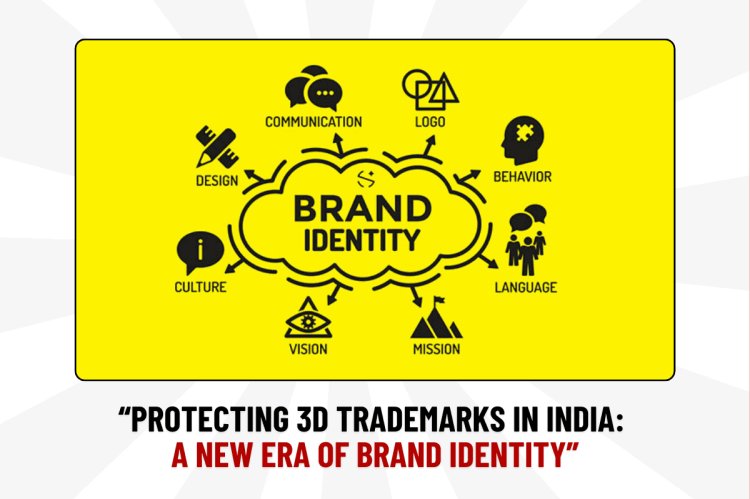“Protecting 3D Trademarks in India: A New Era of Brand Identity”
The concept of trademarks has evolved considerably over time, moving from simple wordmarks and logos to more complex and distinctive types like sound, color, and 3D trademarks. A 3D trademark refers to the registration of a shape or form that represents a product or its packaging, which can distinguish one brand from another. In India, the growing importance of 3D trademarks is evident with businesses looking to leverage unique product designs as part of their brand identity. This paper delves into the regulatory framework governing 3D trademarks in India, the criteria for their protection, challenges businesses face, and the significance of such protection in the competitive market landscape. A 3D trademark applies when a product’s distinctiveness in the market is derived from its shape or packaging. Unlike traditional trademarks that consist of 2D elements such as words, numbers, or logos, a 3D mark is a tangible aspect of the product itself. For example, the shape of the

1. INTRODUCTION
The concept of trademarks has evolved considerably over time, moving from simple wordmarks and logos to more complex and distinctive types like sound, color, and 3D trademarks. A 3D trademark refers to the registration of a shape or form that represents a product or its packaging, which can distinguish one brand from another. In India, the growing importance of 3D trademarks is evident with businesses looking to leverage unique product designs as part of their brand identity. This paper delves into the regulatory framework governing 3D trademarks in India, the criteria for their protection, challenges businesses face, and the significance of such protection in the competitive market landscape.
A 3D trademark applies when a product’s distinctiveness in the market is derived from its shape or packaging. Unlike traditional trademarks that consist of 2D elements such as words, numbers, or logos, a 3D mark is a tangible aspect of the product itself. For example, the shape of the Ferrero Rocher chocolate packaging, the Coca-Cola bottle, or the 4-bar design of KitKat are classic examples of 3D trademarks. The essential criterion in granting a 3D trademark is whether the product’s shape or packaging sets it apart from competitors and is recognized by the public as indicative of the product itself.
2. LEGAL FRAMEWORK
In India, under the Trade Marks Act, 1999, a mark, whether conventional or non-conventional (including 3D marks), must meet two primary conditions for registration. First, the mark must be capable of graphical representation. Second, it must possess a distinct character, enabling it to distinguish the goods or services it represents. This distinction is crucial because it underscores the functional and aesthetic aspects of 3D trademarks, which are typically non-traditional in form.
Despite the conventional nature of trademark requirements, India has progressed significantly by granting protection to 3D marks. A noteworthy example is the protection accorded to the Zippo lighter’s shape in 1996. This marked a turning point in how India addressed 3D trademarks. In the Zippo Manufacturing Company v. Anil Moolchandani[1] case, the court provided a permanent injunction against counterfeit Zippo lighters, recognizing the registration of Zippo's distinctive 3D shape. Similarly, in Gobatschow Wodka VG v. John Distilleries Ltd.[2], the court ruled in favor of protecting the unique shape of the vodka bottle as part of the brand’s goodwill.
2.1 Definition and Recognition: A 3D trademark can be defined as a shape or configuration of goods that is used to distinguish one product from others. The recognition of such trademarks in India is relatively new. The Trade Marks Act, 1999, lays the foundation for registering non-conventional trademarks, including 3D marks. Section 2(1)(zb) defines a trademark as any mark capable of graphical representation and capable of distinguishing goods or services.
2.2 Registration Process: The registration of 3D marks in India follows the same process as traditional trademarks. However, applicants must establish that the shape has acquired distinctiveness through extensive use. The mark must also not be functional in nature. For instance, a functional shape like the shape of a chair or container that solely contributes to its utility may not qualify for protection.
The applicant must file a trademark application with the Controller General of Patents, Designs, and Trademarks, supported by visual representations of the 3D mark, and evidence of its distinctiveness.
2.3 Relevant Provisions under the Trade Marks Act, 1999:
● Section 9(3): Prevents the registration of 3D marks if the shape results from the nature of goods or is necessary to obtain a technical result.
● Section 2(m): Defines “mark” to include the shape of goods, their packaging, or combination thereof.
● Section 32: Discusses acquired distinctiveness, allowing even descriptive or non-distinctive 3D marks to be registered if they have gained secondary meaning in the market.
3. KEY CONSIDERATIONS FOR 3D TRADEMARKS AND CASE STUDY: FERRERO ROCHER IN INDIA
While Ferrero Rocher failed to secure a 3D trademark in Singapore, it succeeded in India. In Ferrero Rocher v. Ruchi International[3] (2018), the Delhi High Court awarded Ferrero damages for trademark infringement due to similar packaging by a Chinese competitor. The court acknowledged Ferrero Rocher's packaging as a well-known trademark and granted it protection under Section 29(5), along with trade dress protection under Section 2(1)(zg) of the Act. This ruling underscores that Ferrero Rocher's packaging now enjoys 3D trademark status in India.
When applying for or assessing 3D trademarks, the following factors are considered:
- Does the shape alone distinguish the product from others?
- Has the shape been graphically represented?
- Does the shape result from the product's natural function or provide a technical result?
- Does the shape instantly evoke the product’s source for consumers?
- Could granting the trademark result in monopolizing a common shape?
- Is there long-term evidence of the shape functioning as a mark?
- Does the shape have goodwill attached to it?
4. CHALLENGES IN PROTECTING 3D TRADEMARKS
4.1 Distinctiveness: One of the biggest hurdles in registering a 3D trademark is proving its distinctiveness. A shape must be capable of acting as a source identifier in the eyes of the public. A merely descriptive or functional shape cannot be trademarked. For example, shapes that are dictated by technical or functional considerations are excluded from registration.
4.2 Functionality Doctrine: The functionality doctrine bars the protection of shapes that are essential for the use of the product. This means that the shape should not be determined by the product’s technical functionality. This principle was upheld in BIC v. Stabilo International, where the court denied trademark protection to the shape of a pen, ruling it was functional rather than distinctive.
4.3 Secondary Meaning: A 3D trademark must acquire secondary meaning to prove that it is associated with a particular brand in the minds of the consumers. This can often require extensive use and advertising, making it more difficult for new businesses to register 3D marks.
4.4 Judicial Interpretation: Indian courts have been cautious in granting trademark protection to 3D shapes. In cases like Gorbatschow Vodka v. John Distilleries, where the shape of the vodka bottle was sought to be protected, the court focused on proving whether the bottle had acquired distinctiveness and was recognized by consumers as belonging to a particular brand.
5. THE SIGNIFICANCE OF PROTECTING 3D TRADEMARKS
5.1 Brand Identity: In the globalized marketplace, 3D trademarks help in building a strong and recognizable brand identity. The protection of unique shapes and designs prevents competitors from copying or diluting the brand's distinctiveness.
5.2 Consumer Recognition: A well-protected 3D trademark creates a visual connection between the product and its source. Consumers can easily identify the brand through the shape, which increases brand loyalty and customer retention.
5.3 Competitive Edge: 3D trademarks offer businesses a competitive edge by preventing competitors from imitating the design. Protecting the physical appearance of a product ensures that only the registered owner can legally use that shape or design.
6. RECENT DEVELOPMENTS AND INTERNATIONAL PERSPECTIVES
6.1 Countries like the United States, European Union, and Japan have developed advanced frameworks for protecting 3D trademarks, though challenges still exist in enforcing and recognizing these marks uniformly. The World Intellectual Property Organization (WIPO) has emphasized the need to harmonize 3D trademark protection globally, providing more clarity for companies seeking to register such marks internationally.
- Japan: In Japan, only visually perceptible marks can be registered, which excludes non-conventional marks like sounds, smells, and flavors. However, 3D marks are registrable if they meet the distinctiveness requirement. Functional shapes or packaging, which are essential to the product’s function, are not eligible for registration.
- United States: Under Section 43(a) of the Lanham Act, both registered and unregistered 3D trademarks, or trade dress, are protected. Trade dress must be either inherently distinctive or acquire secondary meaning over time. Inherently distinctive shapes instantly identify the product’s source, while shapes that lack this distinctiveness can gain protection if consumers associate them with the brand over time. Courts, such as in Foamation, Inc. v. Alamo Flags, Inc., have recognized secondary meaning for unique product shapes. Functional shapes, essential for product utility, are not registrable, but non-functional shapes that have gained distinctiveness can be.
- Other Countries: Countries like Argentina, Portugal, Australia, Singapore, Taiwan, and New Zealand allow 3D trademark registration but face difficulties in proving distinctiveness, as many product shapes are viewed as functional. In jurisdictions like Nigeria and South Africa, 3D marks lack explicit legal protection, leading applicants to seek protection under industrial design or patent laws.
6.2 India’s Progress: India is increasingly acknowledging the importance of non-traditional trademarks, including 3D marks, especially in the food, beverage, and luxury goods sectors. While still evolving, India's legal framework is catching up with global standards, as demonstrated by notable cases like Ferrero Rocher v. Ruchi International.
7. CONCLUSION
As brands strive to establish unique identities in an increasingly competitive marketplace, the protection of 3D trademarks in India has gained significant importance. While the legal framework for 3D trademarks exists under the Trade Marks Act, 1999, businesses continue to face challenges in proving distinctiveness and navigating the functionality doctrine. Judicial interpretation in India remains cautious, but with the growing influence of globalization and heightened consumer awareness, the landscape is gradually evolving.
The registration and protection of 3D trademarks present unique difficulties, as they do not conform to the traditional notion of trademarks that are easily represented graphically. Instead, 3D trademarks must demonstrate distinctiveness while avoiding functionality issues. Although India’s legal framework aligns with international standards, clearer guidelines are necessary to aid trademark registrars and courts in effectively evaluating 3D marks.
As international jurisprudence on 3D trademarks evolves, India is expected to take inspiration from global practices and refine its approach to brand protection. Ultimately, the success of a 3D trademark lies in its ability to distinguish a product within the marketplace, going beyond its functional or aesthetic qualities, and creating a recognizable brand identity.












